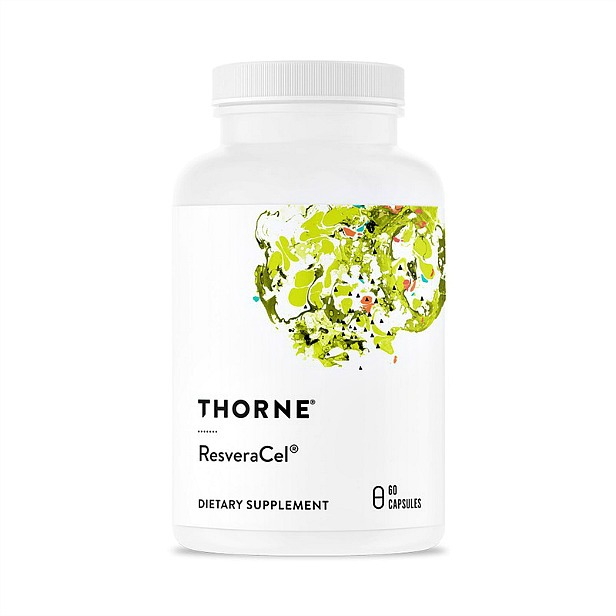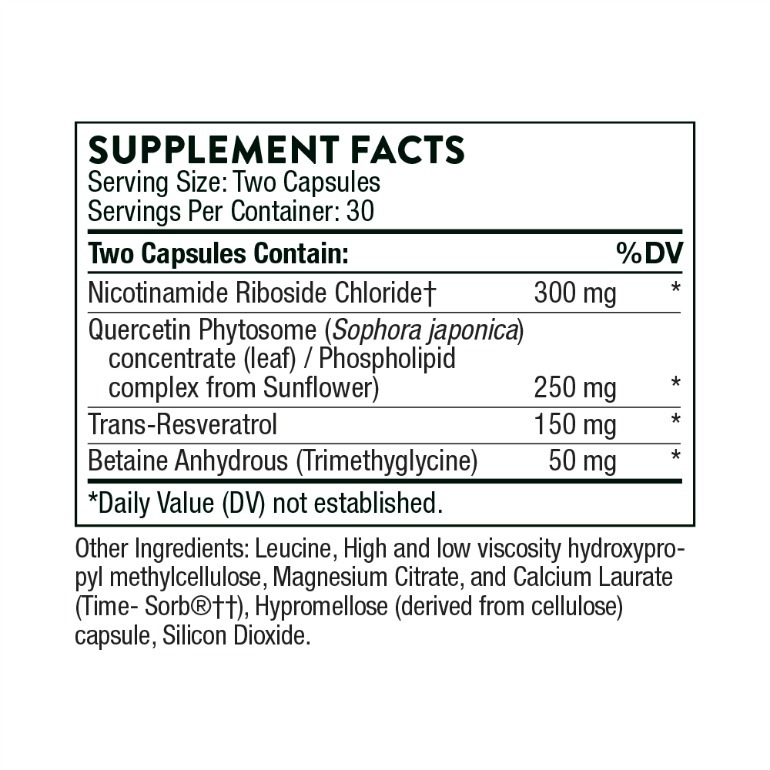nicotinamide riboside
In December 2013 edition of a scientific journal Cell a group of scientists led by David Sinclair
(professor of genetics at Harvard Medical School),
published data showing that by using the most recent achievements in molecular biology and genetics, it
may be possible to reverse the aspects of aging [8].
For one week, researchers fed a 2-year-old mouse (equivalent of about 65 human years) a diet supplemented
by a simple chemical present in nature (which raised NAD+ level inside cells) were able to obtain in examined
tissues the level of metabolism and life activities typical for a 6-month-old mouse (like a human
in his twenties).
One of the most important hallmarks of aging observed in biology is a progressive decline in
mitochondrial function with age. This is probably the main reason of loss of cellular homeostasis
which leads to health problems [7].
Both nucleus and mitochondria have DNA responsible for encoding oxidative
phosphorylation which is a proper pathway for producing energy by mitochondria.
A good example of improper cellular metabolism is a shift away from oxidative
phosphorylation toward anaerobic glicolisys observed in growing cancerous tumors (known as Warburg
reprogramming or Warburg effect).
In order to coordinate cellular metabolism well, good communication between nucleus and mitochondria
is necessary. Researchers postulate that loss of communication caused by a genetic
defect in the mitochondrial subunits which encode oxidative phosphorylation, is responsible for
loss of cellular function and aging.
It seems that the defect is showing mostly because of progressive age loss of cellular NAD+.
That is why supplementation leading to an increase of that important chemical in our cells
may lead to improvement in communication between nucleus and mitochondria and that in turn
may reverse metabolic clock and the aspects of aging.
Supplementation with NAD+ is impossible because it doesn't cross cellular wall.
The only scientifically proven supplement [1] to increase NAD+ level in cellular structures
is Nicotinamide Riboside which is available in capsules and taken orally.
In order to understand the way NAD+ works inside living cells, one must know the role
of sirtuin genes and sirtuin proteins which are encoded by them, and have enzymatic activity.
Sirtuins are responsible for epigenetic regulation of the expression of our genes.
Sirtuins control proper metabolism, inflammatory response, cell cycle, circadian cycle,
tumorigenesis, DNA repair, insulin secretion, ammonia detoxyfication, TNF secretion, rDNA transcription,
and other aspects of cellular life [6].
NAD+ is a rate-limiting coenzyme for sirtuins. That means that its dropping level parallel with aging has a direct
influence on the activity of sirtuins and is probably responsible for the fact that during aging process our genes
are not being read properly (they are not being regulated properly by sirtuins).
The first natural stimulator of sirtuins was resveratrol [9]. Researchers stimulated sirtuins with that plant
polyphenol and were thus able to extend a life span of a living organism by 70%. Stimulators of sirtuins working like
resveratrol don't seem to be beneficial without appriopriate presence in cell of its rate-limiting coenzyme NAD+ [10].
Appropriate level of NAD+ is directly responsible for a proper activity of sirtuins, which
decide how our bodies are responding to diet, exercise and other environmental factors. On a cellular level,
suplementation with NAD+ causes increased activity and number of mitochondria, better metabolism,
better homeostasis, and may ward off diseases of aging and possibly even reverse the aspects of aging
process.
In opinion of a scientist involved in the breakthrough discoveries in
genetics and molecular biology mentioned here, by using what is presently
known about aging process, it may be possible to extend human lifespan by up to 50% [10].
Distributors of Nicotinamide Riboside closely watch
its influence on human organism. No serious side effects have been recorded so far (since the introduction of product known then as Niagen
to the market of supplements in 2013). If such events occur we will report them on our website.
So far many people have described health benefits of using Niagen and their testimonials
are available on internet. It seems that the older the person the better result one can expect.
Older people are supposed to have bigger deficit of NAD+.
Zygmunt Wojtowiec, MD
Internal Medicine
[1] Cell Metab. 2012 Jun 6;15(6):838-47. doi: 10.1016/j.cmet.2012.04.022.
The NAD(+) precursor nicotinamide riboside enhances oxidative metabolism and protects against high-fat diet-induced obesity.
Carles Cantó,1,*+ Riekelt H. Houtkooper,1,*+ Eija Pirinen,1,2 Dou Y. Youn,3 Maaike H. Oosterveer,1 Yana Cen, 3 Pablo J. Fernandez-Marcos,1 Hiroyasu Yamamoto,1 Pénélope A. Andreux,1 Philippe Cettour-Rose,1 Karl Gademann, 4 Chris Rinsch,5 Kristina Schoonjans,1 Anthony A. Sauve,3 and Johan Auwerx1
1École Polytechnique Fédérale de Lausanne, CH-1015, Lausanne, Switzerland
2Biotechnology and Molecular Medicine, A.I. Virtanen Institute for Molecular Sciences, Biocenter Kuopio, University of Eastern Finland, Kuopio, Finland
3Department of Pharmacology, Weill Cornell Medical College, New York, NY, USA
4Department of Chemistry, University of Basel, CH-4056, Basel, Switzerland
5Amazentis, Quartier de L’innovation EPFL, CH-1015 Lausanne, Switzerland
[2] EMBO Mol Med. 2014 May 16;6(6):705-7. doi: 10.15252/emmm.201404179.
Salvaging hope: Is increasing NAD(+) a key to treating mitochondrial myopathy?
Lightowlers RN1, Chrzanowska-Lightowlers ZM1.
1Wellcome Trust Centre for Mitochondrial Research, Institute for Cell and Molecular Biosciences Medical School Newcastle University, Newcastle upon Tyne, UK.
[3] J Pharmacol Exp Ther. 2008 Mar;324(3):883-93. doi: 10.1124/jpet.107.120758. Epub 2007 Dec 28.
NAD+ and vitamin B3: from metabolism to therapies.
1Department of Pharmacology, Weill Medical College of Cornell University, 1300 York Avenue, New York, NY 10021, USA.
[4] Nature 483, 218–221 (08 March 2012) doi:10.1038/nature10815 Received 17 December 2010 Accepted 19 December 2011 Published online 22 February 2012
The sirtuin SIRT6 regulates lifespan in male mice.
Authors: Yariv Kanfi, Shoshana Naiman, Gail Amir, Victoria Peshti, Guy Zinman, Liat Nahum, Ziv Bar-Joseph & Haim Y. Cohen
Affiliations:
The Mina & Everard Goodman Faculty of Life Sciences, Bar-Ilan University, Ramat-Gan 52900, Israel Yariv Kanfi,
(Shoshana Naiman, Victoria Peshti, Liat Nahum & Haim Y. Cohen
Department of Pathology, Hadassah Medical Center and Hebrew University, Kiryat Hadassah, Jerusalem 91120, Israel
(Gail Amir)
Lane Center for Computational Biology, School of Computer Science, Carnegie Mellon University, Pittsburgh, Pennsylvania 15217, USA
(Guy Zinman & Ziv Bar-Joseph)
[5] Trends Cell Biol. 2014 Aug;24(8):464-71. doi: 10.1016/j.tcb.2014.04.002. Epub 2014 Apr 29.
NAD+ and sirtuins in aging and disease.
Imai S1, Guarente L2.
1Department of Developmental Biology, Washington University School of Medicine, St. Louis, MO 63110, USA. Electronic address: imaishin@wustl.edu.
2Department of Biology, Massachusetts Institute of Technology, Cambridge, MA 02139, USA; Glenn Laboratory for the Science of Aging, Massachusetts Institute of Technology, Cambridge, MA 02139, USA; Koch Institute for Integrative Cancer Research, Massachusetts Institute of Technology, Cambridge, MA 02139, USA.
[6] https://en.wikipedia.org/wiki/Sirtuin
[7] https://www.youtube.com/watch?v=v3ncUYKme4k
[8] Cell. 2013 Dec 19; 155(7): 1624–1638.
doi: 10.1016/j.cell.2013.11.037
Declining NAD+ Induces a Pseudohypoxic State Disrupting Nuclear-Mitochondrial Communication during Aging.
Authors:
Ana P. Gomes,1,2,3 Nathan L. Price,1 Alvin J.Y. Ling,1 Javid J. Moslehi,4,5 Magdalene K. Montgomery,6 Luis Rajman,1 James P. White,7 João S. Teodoro,2,3 Christiane D. Wrann,7 Basil P. Hubbard, 1 Evi M. Mercken,8 Carlos M. Palmeira,2,3 Rafael de Cabo,8 Anabela P. Rolo,2,9 Nigel Turner,6 Eric L. Bell,10 and David A. Sinclair1,6,*
Affiliations:
1Glenn Labs for the Biological Mechanisms of Aging, Department of Genetics, Harvard Medical School, Boston, MA 02115, USA
2Center for Neurosciences and Cell Biology, 3004-517 Coimbra, Portugal
3Department of Life Sciences, Faculty of Science and Technology, University of Coimbra, 3004-517 Coimbra, Portugal
4Department of Medical Oncology, Brigham and Women’s Hospital and Dana-Farber Cancer Institute, Harvard Medical School, Boston, MA 02115, USA
5Division of Cardiovascular Medicine, Department of Medicine, Brigham and Women’s Hospital, Harvard Medical School, Boston, MA 02115, USA
6Department of Pharmacology, School of Medical Sciences, The University of New South Wales, Sydney NSW 2052, Australia
7Dana-Farber Cancer Institute, Department of Cell Biology, Harvard Medical School, Boston, MA 02115, USA
8Laboratory of Experimental Gerontology, National Institute on Aging, National Institutes of Health, Baltimore, MD 21224, USA
9Department of Biology, University of Aveiro, 3810-193 Aveiro, Portugal
10Department of Biology, Massachusetts Institute of Technology, Paul F. Glenn Laboratory for the Science of Aging, Cambridge, MA 02139, USA
[9] Nature. 2003 Sep 11;425(6954):191-6. Epub 2003 Aug 24.
Small molecule activators of sirtuins extend Saccharomyces cerevisiae lifespan.
Howitz KT1, Bitterman KJ, Cohen HY, Lamming DW, Lavu S, Wood JG, Zipkin RE, Chung P, Kisielewski A, Zhang LL, Scherer B, Sinclair DA.
1BIOMOL Research Laboratories, Inc., 5120 Butler Pike, Plymouth Meeting, Pennsylvania 19462, USA.
[10] https://www.youtube.com/watch?v=1DT6MUUdZDs
[11] https://www.youtube.com/watch?v=_QUgyxDs1oc
[12] http://www.who.int/healthinfo/survey/ageingdefnolder/en/
[13] https://pl.wikipedia.org/wiki/HeLa
ABSTRACT:
We are currently observing slow but constant progress in extension of human life due to many factors (including achievements in conventional medicine) but the percentage of our lives spent in good health is getting smaller.
In December 2013 edition of a scientific journal Cell, a group of scientists (led by David Sinclair, a professor of genetics at Harvard Medical School), published data suggesting that not only is extension of life possible but we can also do something to improve its quality and even reverse aspects of aging.
Researches point to loss of communication between the genetic material of nucleus and mitochondria as the main reason of aging. It seems to be caused by dropping level of NAD+ also observed with aging.
It was shown that supplementation which raises the level of NAD+ inside proper compartments of our cells, may fix the problem in communication between nucleus and mitochondria and improve the effectiveness in energy production, as well as increase the number of mitochondria in our cells. Better metabolism may be visible as reversal of aspects of aging.
Because NAD+ itself does not cross cellular wall it cannot be used as a supplement. The only scientifically proven dietary supplement (available since 2013) which can efficiently raise the level of NAD+ in our cells is nicotinamide riboside.

